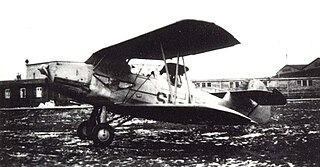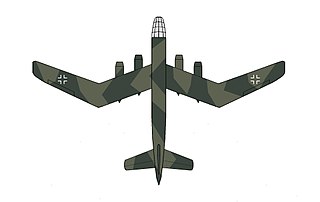| Arado E.561 | |
|---|---|
| Role | Heavy fighter |
| National origin | Germany |
| Manufacturer | Arado Flugzeugwerke |
| Status | Not Produced |
The Arado E.561 was a proposed Heavy fighter design by Arado Flugzeugwerke, designed in 1937 and 1938.
| Arado E.561 | |
|---|---|
| Role | Heavy fighter |
| National origin | Germany |
| Manufacturer | Arado Flugzeugwerke |
| Status | Not Produced |
The Arado E.561 was a proposed Heavy fighter design by Arado Flugzeugwerke, designed in 1937 and 1938.
The craft contained a cigar-shaped fuselage with low-mounted wings. Unusually, it contained two engines mounted in the junction of the wing and the fuselage, as opposed to on the wings, to allow it to continue running if one engine failed. This also would allow a sleeker and more aerodynamic design. Two annular radiators were present on front of the propellers. It had two landing wheels, both of which could retract. It was crewed by four people. It is likely that the complicated design of the engine was what caused the abandonment of the project.

The Arado Ar 80 was a pre-World War II fighter aircraft, designed by Arado Flugzeugwerke to compete for the Luftwaffe's first major fighter contract. The Ar 80 was uninspiring in terms of performance and also suffered a number of failures. The contest was eventually won by the Messerschmitt Bf 109, and the Ar 80 prototypes ended their days as test aircraft.

The Arado Ar 234 Blitz is a jet-powered bomber designed and produced by the German aircraft manufacturer Arado. It was the world's first operational turbojet-powered bomber, seeing service during the final years of Second World War.

The Arado Ar 196 was a shipboard reconnaissance low-wing monoplane aircraft built by the German firm of Arado starting in 1936. The next year it was selected as the winner of a design contest and became the standard aircraft of the Kriegsmarine throughout World War II.

The Arado Ar 240 was a German twin-engine, multi-role heavy fighter aircraft, developed for the Luftwaffe during World War II by Arado Flugzeugwerke. Its first flight was in 1940, but problems with the design hampered development, and it remained only marginally stable throughout the prototype phase. The project was eventually cancelled, with the existing airframes used for a variety of test purposes.

A nacelle is a "streamlined body, sized according to what it contains", such as an engine, fuel, or equipment on an aircraft. When attached by a pylon entirely outside the airframe, it is sometimes called a pod, in which case it is attached with a pylon or strut and the engine is known as a podded engine. In some cases—for instance in the typical "Farman" type "pusher" aircraft, or the World War II-era P-38 Lightning—an aircraft cockpit may also be housed in a nacelle, rather than in a conventional fuselage.

The Arado Ar 231 was a lightweight floatplane, developed during World War II in Germany as a scout plane for submarines by Arado. The need to be stored inside the submarine necessitated compromises in design that made this single-seat seaplane of little practical use.

The Henschel Hs 132 was a World War II dive bomber and interceptor aircraft of the German Luftwaffe that never saw service. The unorthodox design featured a top-mounted BMW 003 jet engine and the pilot in a prone position. The Soviet Army occupied the factory just as the Hs 132 V1 was nearing flight testing, the V2 and V3 being 80% and 75% completed.

The Arado Ar 232 Tausendfüßler, sometimes also called Tatzelwurm, was a cargo aircraft, designed and built in small numbers by the German firm Arado Flugzeugwerke during World War II. The design introduced, or brought together, almost all of the features now considered to be standard in modern cargo transport aircraft designs, including a box-like fuselage slung beneath a high wing; a rear loading ramp ; a high-mounted twin tail for easy access to the hold; and various features for operating from rough fields. Although the Luftwaffe was interested in replacing or supplementing its fleet of outdated Junkers Ju 52/3m transports, it had an abundance of types in production at the time, and did not purchase large numbers of the Ar 232.

The Arado Ar 66 was a German single-engined, two-seat training biplane, developed in 1933. It was also used for night ground-attack missions on the Eastern Front. It was engineer Walter Rethel's last design in collaboration with Arado, before Walter Blume, assigned as Arado Flugzeugwerke's chief design engineer in 1933, took over the bulk of the Arado firm's design duties.

A podded engine is a jet engine that has been built up and integrated in its nacelle. This may be done in a podding facility as part of an aircraft assembly process. The nacelle contains the engine, engine mounts and parts which are required to run the engine in the aircraft, known as the EBU. The nacelle consists of an inlet, an exhaust nozzle and a cowling which opens for access to the engine accessories and external tubing. The exhaust nozzle may include a thrust reverser. The podded engine is a complete powerplant, or propulsion system, and is usually attached below the wing on large aircraft like commercial airliners or to the rear fuselage on smaller aircraft such as business jets.

The de Havilland DH.27 Derby was a large single-engined biplane designed to a heavy day bomber Air Ministry specification. It did not reach production.
The Arado Ar 81 was a German prototype dive bomber. Because the Reich Air Ministry decided to purchase the competing Junkers Ju 87, only three prototypes of the Ar 81 were completed.

The Arado E.381 was a proposed parasite fighter aircraft. Conceived by Arado Flugzeugwerke in December 1944 for Germany's Luftwaffe during World War II, the E.381 was to have been carried aloft by and launched from an Arado Ar 234 "mother" aircraft. It would then have activated its rocket engine, which would have propelled it to attack Allied bombers. Development was cancelled due to lack of funds and official support.

The Arado Ar E.340 was a twin-engined dive- and tactical-medium bomber, designed by Arado Flugzeugwerke at the request of the Reich Air Ministry in 1939 to compete for a production contract for the Bomber B fast bomber design competition, but the project was cancelled.

The Arado Ar 77 was a German twin-engined monoplane, designed as an advanced training aircraft from 1934.

The Blohm & Voss Bv P 188 was a long-range, heavy jet bomber design project by the Blohm & Voss aircraft manufacturing division during the last years of the Third Reich. It featured a novel W-wing planform with variable incidence.
The Arado E.583 was a project design from 1945 for a jet-powered night fighter aircraft of the German manufacturer Arado Flugzeugwerke.
The Arado E.530 was a proposed twin-engine Schnellbomber design by Arado Flugzeugwerke. It was to have a pressurized cockpit in the port fuselage and contained one 500 kg bomb, but was otherwise unarmed. It was abandoned due to having no advantage over the Messerschmitt equivalent.
The Arado E.654 was a German heavy fighter project by Arado Flugzeugwerke.
The Messerschmitt P.1107 was a jet-powered bomber project developed in the final years of the Second World War.